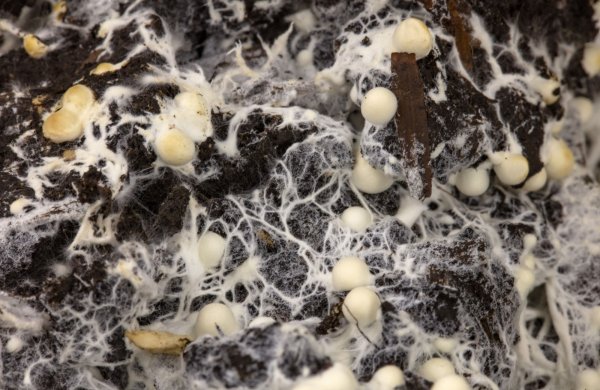
Longread
Mushroom mycelium as a promising future source of protein
Picture the scene: cavernous factory buildings or tunnels containing vast quantities of mycelium (the network of fungal threads that produce mushrooms) growing on olive pulp, wood chips or cocoa pods. Researchers at Wageningen University & Research are investigating how mushroom-forming fungi could become an alternative source of protein for food. 'These magical organisms offer a world of untapped potential.'

Mushroom-forming fungi can play an important and complementary role in the protein transition.
Proteins are an important part of our diet, and they also influence the structure and texture of foods.But the way we currently produce proteins is unsustainable. Protein is also unfairly distributed around the world. “We need to eat more proteins from plants and micro-organisms, and also ensure a better distribution of these nutrients so that people from other parts of the world also have access to healthy high-protein food,” says researcher Karin Scholtmeijer. “Many people are unaware that mushroom-forming fungi can play an important and complementary role in the protein transition.”
A range of structures, colours and fragrances
That’s why Scholtmeijer and her colleagues are growing 60 types of mycelium in their lab, using all sorts of cultivation conditions and substrates. These range from beetroot pulp to wood chips. “When you look at them as a whole, there’s a huge range of structures, colours and fragrances,” says Scholtmeijer. “Mushroom-forming fungi break down waste matter from vegetables, fruit and woody debris and convert it into other forms, such as food. What’s really unique about these organisms is their ability to convert the tough, woody compounds in this waste matter. We’re looking for fungi with a high protein content and we’re looking specifically at the mycelium that is normally discarded in mushroom production. We’re analysing the proteins found in each species, and the properties of those proteins.”

A world of possibilities
In the future, according to Karin Scholtmeijer, we might find a wide variety of fragrant, colourful and high-protein
mushroom mycelium products in the refrigerated sections of supermarkets. “If mycelium is grown on 'food-grade' residues, like olive pulp or fruit residues, you could just eat it as it is. You can also make all kinds of other products from it, depending on how much you want to process it. You can dry it, grind it, add it to other foods in powder form, or make drinks with it, such as protein shakes. It’s a circular production method. That makes it good for our planet and the environment. Over time, these mycelia can be improved further in terms of their taste and smell, and their protein value will also increase,” says Scholtmeijer. “We can achieve this by screening thousands of new species, breeding promising species in the traditional way, or by combining molecular or classical modification techniques. This is something we’re researching in our lab too.”
Our research is paving the way towards the production of healthy, tasty foods based on mushroom mycelium.
Our supermarket shelves will also increasingly feature products containing protein powder, made from protein derived from mycelium grown on what are now still inedible substrates such as cocoa pods, a residue of cocoa bean production. “It will be important to ensure that any protein we extract and purify doesn’t still contain any toxic substances,” says Scholtmeijer. “Products must be safe to eat. On the other hand, certain components of the fungus that find their way into the powder can actually have a positive effect. The protein powder could be very useful for all kinds of food products, such as bread or meat substitutes that are already on the market. In countries where there are food shortages, there could be a real benefit, especially if there are improvements to both the protein levels and protein quality.”
Scholtmeijer is also enthusiastic about the opportunities that are emerging for the use of mushroom-forming fungi in non-food applications. “Residues from mycelium cultivation can themselves be used again, for example by converting them into biogas or using them in the production of green chemicals. That saves farmland, because at present plants are grown specifically for that purpose.”
Growing mushroom mycelium in factories and tunnels
Scholtmeijer hopes that in the future we’ll see mycelium from mushroom-forming fungi being cultivated in many more production sites all over the world. This won’t require any large expanses of agricultural land: any empty factory buildings or tunnels will do. And the emergence of innovations such as 'vertical farming' can also lend themselves to growing fungi. “We want to maximise the potential of mycelium from mushroom-forming fungi as a supplementary source of protein for food. It’s important for consumers to be part of this process, because ultimately it’s up to them to decide what they want to eat. Our research is paving the way towards the production of healthy, tasty foods based on mushroom mycelium.”
Research line chosen by employees and students
The research line led by Scholtmeijer was launched with funding from Wageningen University & Research (protein transition theme). This project was chosen by employees and students as one of six research projects that are being funded for their potential contribution to the development of alternative protein sources.